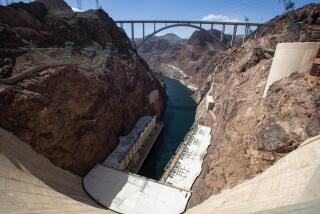Editorial: Proposed DWP rate hike isn’t high enough
This week, the City Council will consider a proposal to raise electricity and water rates for homes and businesses in Los Angeles. The plan would increase the typical residential customer’s monthly Department of Water and Power bill incrementally each year so that at the end of five years it would be $21 more than today. Unlike past attempts to hike rates, this proposal has been met with broad support. The DWP held dozens of briefings with neighborhood councils, business groups and environmental organizations. The city’s ratepayer advocate called the increases “just and reasonable.” Mayor Eric Garcetti said the higher rates are needed to modernize the city’s aging electricity grid and water system.
The DWP is mired in bureaucracy and politics, and it struggles ... because managers answer to multiple layers of political bosses.
They’re right. The City Council should approve the increased charges without delay. But even as it does so, it should acknowledge honestly that the new rates would still be too low to pay for everything the DWP needs to do, and that the utility will fall further behind on maintenance and modernization unless and until city leaders reform the DWP and its governance structure.
The utility’s needs are vast. The DWP has to finish covering all the city’s reservoirs to protect drinking water; step up dust control in the Owens Valley as part of a legal settlement; clean up contaminated groundwater in the San Fernando Valley; switch from dirty coal to clean, renewable sources; modernize its gas power plants and rebuild its coastal power plants so they no longer suck in ocean water and sea life, and help customers make their homes and businesses more water and energy efficient. And those are just the mandates. The utility also has ambitious plans to recycle toilet water, capture storm water and help more customers install rooftop solar. And there remains a staggering backlog of basic maintenance to be done, from 100-year-old water trunk lines to splintered power poles.
In analyzing the rate proposals, the ratepayer advocate found that they wouldn’t allow the department to replace water main lines fast enough to keep the system from springing leaks. Nor would there be enough money to replace the pipes and valves that have outlived their useful life.
Given the enormous demands, why shouldn’t rates be raised even more? Because — as the ratepayer advocate has noted and DWP officials themselves concede — the utility has been having difficulty in recent years spending the money it has collected. The DWP is mired in bureaucracy and politics, and it struggles to hire enough workers, to contract with outside companies for work and to make timely business decisions, because managers answer to multiple layers of political bosses.
That’s why the rate discussion has been inextricably linked to the debate over how to reform the agency’s governance. The City Council has begun holding forums on this, but governance reform is complicated — and a vote of the people is required to change the city charter.
There have been five separate recommendations in 16 years to fix the DWP’s structure — including one last month from Councilman Felipe Fuentes — but City Hall has not had the appetite for serious change. A number of questions need to be addressed, including: Should the ultimate decisions on issues such as rate hikes and hiring of a new general manager continue to be made by elected officials in City Hall or by a more independent board shielded from political meddling? Do civil service rules need to be loosened to allow the utility to do its own hiring, and if so, how can workers be protected from favoritism, nepotism and politicized hiring? How much of the money paid by ratepayers should be sent to City Hall to feed its general fund budget needs?
Reform is essential and long overdue. But that important discussion shouldn’t delay the higher rates needed to keep the utility running now. The rate hike plan includes some smart changes designed to encourage conservation and more efficient management. The water rate proposal, for instance, increases the number of pricing tiers from two to four. Customers who stay within in their allotment would pay a modestly higher rate. By 2019, the most excessive users would pay a rate nearly twice as high as the lowest users. The power rate increases the money available to help customers make their homes and businesses more efficient.
The council should enact the rate hikes.
Follow the Opinion section on Twitter @latimesopinion and Facebook
MORE EDITORIALS
KKK group got exactly what it wanted: lots of free attention
Why Super Tuesday could stand to be a little less super
Chief Beck needs to explain why we need thousands of extra cops
More to Read
A cure for the common opinion
Get thought-provoking perspectives with our weekly newsletter.
You may occasionally receive promotional content from the Los Angeles Times.






